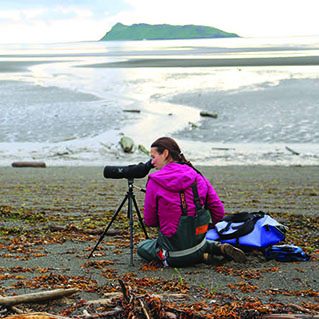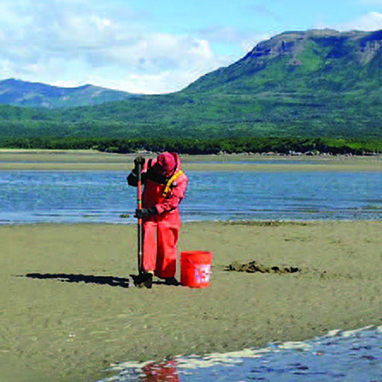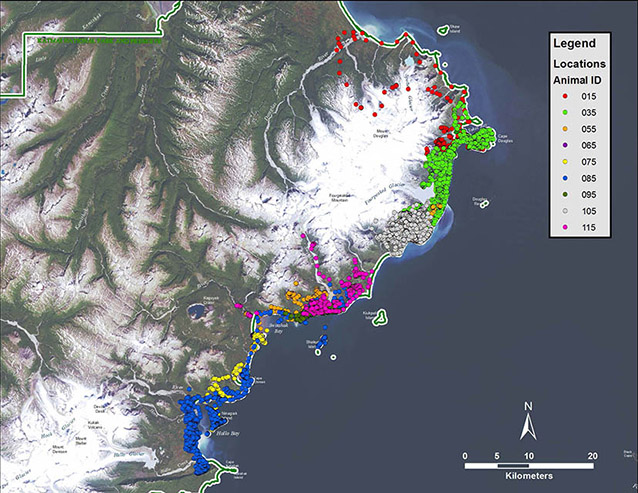Changing Tides is a three-year project that researches the importance of marine intertidal resources to brown bear health and the vulnerability of these resources to environmental changes. The study takes place in both Katmai and Lake Clark National Parks and is a collaborative effort with the U.S. Geological Survey, Washington State University, the Alaska SeaLife Center, and the National Park Service.
Preliminary Finds For 2015

NPS Photo/K. Chritz
Each summer, thousands of visitors are drawn to the Pacific Coast of Katmai and Lake Clark National Parks for their exceptional opportunities for bear viewing and wildlife photography. Throughout the season, brown bears congregate in areas with concentrated marine-influenced food resources including sedge, salmon and marine invertebrates such as clams and mussels. Changing Tides, a cooperative project between the National Park Service, US Geological Survey, Washington State University and the Alaska SeaLife Center, is investigating this unique link between the terrestrial and marine environments, particularly as it relates to bears, mussels and clams. Questions we are seeking to answer during this three-year study are the following: How much nutrition does shellfish actually provide for brown bears? How healthy are the shellfish populations currently? Would it matter if these populations were impacted by human-caused changes such as increasing ocean acidity, over-harvesting, or another oil spill? Finally, at what point does human presence on these same beaches affect bear behavior and their access to marine food resources?
Clams and Mussels

USGS Photo/L. Bowen
During the summer of 2015, marine ecologists began investigating the extent and health of mussel and clam communities along the Katmai and Lake Clark coasts. Ecologists surveyed areas in both parks known for mussels and clams. In a subset of these areas, clams and mussels were collected and transported to the Alaska SeaLife Center where a variety of measurements were taken including measuring clam and mussel feeding rates, and recording mussel byssal thread production. These measurements, as well as a suite of others, help researchers understand the overall health of these invertebrates. Researchers are also identifying genetic markers that will tell them whether clams and mussels have been exposed to stressors such as increases in temperature, changing pH levels, and hydrocarbons. Developing these analytical techniques will help resource managers better evaluate human-caused impacts to the marine community. Surveys and laboratory analysis will continue in 2016.
Brown Bears
This summer, wildlife biologists will continue behavioral observations of coastal bears along with collaring and sample collection from a small number of bears. In 2015, nine bears on the Katmai coast were fitted with GPS collars to evaluate their use of coastal habitats (see map). The coastal bears in this study have been found to occupy relatively small areas, staying within about 3.5 miles of the coast, and traveling between 5 to 22 miles along the coast over the entire observed season (based on data from three collars; late May to early October). Some bears do occasionally make longer forays inland or even onto islands. Researchers are continuing to analyze the fine-scale habitat selection of bears within their home-ranges using GPS locations collected from collars and mapping software. Video footage collected from two collars is providing researchers with a bears-eye view of habitat selection.

Samples collected from the 2015 field study, including hair, blood, and diet items (including clams and vegetation) are currently being analyzed to determine what bears are eating when we can’t observe them. The nutritional value of these food items is also being analyzed to better understand why bears choose certain foods over others. From observations last summer, researchers know that bears can consume approximately 0.75 soft shell clams and 58 bites of sedge per minute. In a comparison of weight gain before and after salmon are available to bears, researchers found that bears were able to gain 1.9 pounds per day before salmon (based on data collected from six bears) and 1.4 pounds per day during the salmon season (based on two individuals), suggesting that early season food resources, such as clams and vegetation can have a significant effect on weight-gain. Weight-gain is important for bears, as their energy reserves help them get through the winter and produce adequate milk for their growing cubs. Researchers will continue to investigate coastal bear diet and habitat selection in 2016.
For more information
Visit Katmai's website or contact:
Carissa Turner, Coastal Biologist
Katmai National Park, King Salmon, AK
carissa_n_turner@nps.gov (907) 246-2104
Grant Hilderbrand, Wildlife Biologist
Alaska Science Center, Anchorage, AK
ghilderbrand@usgs.gov (907) 786-7076
Part of a series of articles titled Changing Tides Articles.
Last updated: September 2, 2016
